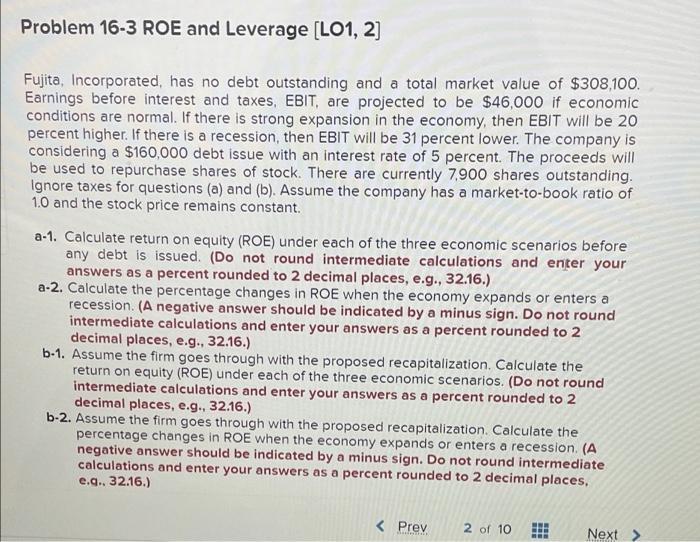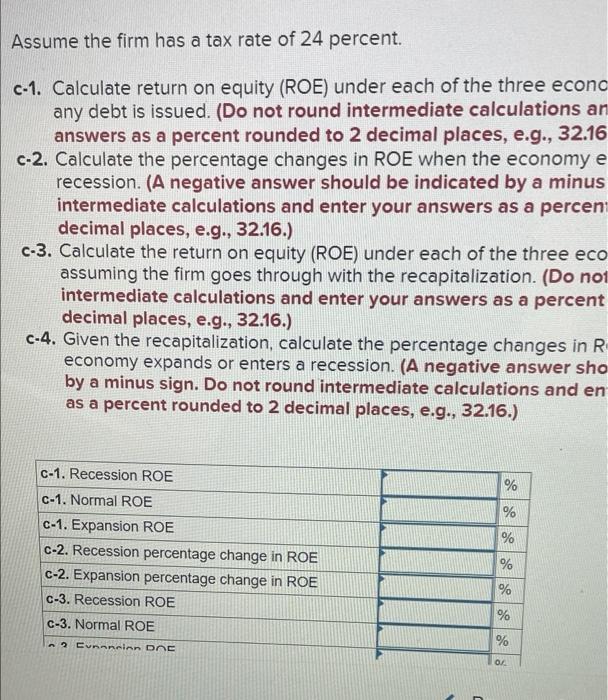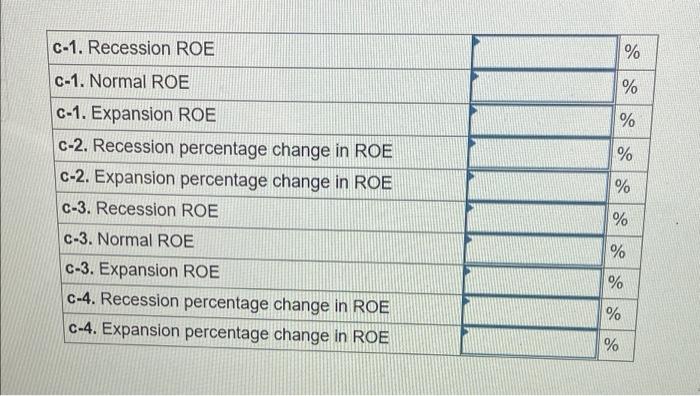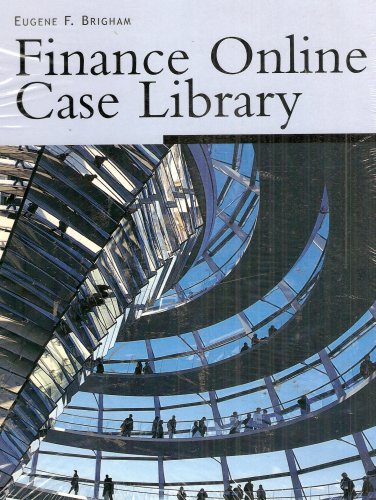Problem 16-3 ROE and Leverage (LO1, 2] Fujita, Incorporated, has no debt outstanding and a total market value of $308,100. Earnings before interest and taxes, EBIT, are projected to be $46,000 if economic conditions are normal. If there is strong expansion in the economy, then EBIT will be 20 percent higher. If there is a recession, then EBIT will be 31 percent lower. The company is considering a $160,000 debt issue with an interest rate of 5 percent. The proceeds will be used to repurchase shares of stock. There are currently 7.900 shares outstanding. Ignore taxes for questions (a) and (b). Assume the company has a market-to-book ratio of 1.0 and the stock price remains constant. a-1. Calculate return on equity (ROE) under each of the three economic scenarios before any debt is issued. (Do not round intermediate calculations and enter your answers as a percent rounded to 2 decimal places, e.g., 32.16.) a-2. Calculate the percentage changes in ROE when the economy expands or enters a recession. (A negative answer should be indicated by a minus sign. Do not round intermediate calculations and enter your answers as a percent rounded to 2 decimal places, e.g., 32.16.) b-1. Assume the firm goes through with the proposed recapitalization. Calculate the return on equity (ROE) under each of the three economic scenarios. (Do not round intermediate calculations and enter your answers as a percent rounded to 2 decimal places, e.g., 32.16.) b-2. Assume the firm goes through with the proposed recapitalization. Calculate the percentage changes in ROE when the economy expands or enters a recession. (A negative answer should be indicated by a minus sign. Do not round intermediate calculations and enter your answers as a percent rounded to 2 decimal places. e... 32.16.) Assume the firm has a tax rate of 24 percent. c-1. Calculate return on equity (ROE) under each of the three econo any debt is issued. (Do not round intermediate calculations an answers as a percent rounded to 2 decimal places, e.g., 32.16 c-2. Calculate the percentage changes in ROE when the economy e recession. (A negative answer should be indicated by a minus intermediate calculations and enter your answers as a percent decimal places, e.g., 32.16.) C-3. Calculate the return on equity (ROE) under each of the three eco assuming the firm goes through with the recapitalization. (Do not intermediate calculations and enter your answers as a percent decimal places, e.g., 32.16.) C-4. Given the recapitalization, calculate the percentage changes in R economy expands or enters a recession. (A negative answer sho by a minus sign. Do not round intermediate calculations and en as a percent rounded to 2 decimal places, e.g., 32.16.) % % % C-1. Recession ROE C-1. Normal ROE C-1. Expansion ROE C-2. Recession percentage change in ROE C-2. Expansion percentage change in ROE C-3. Recession ROE C-3. Normal ROE Cuneneinn DC % % % % J C-1. Recession ROE % C-1. Normal ROE % % % % C-1. Expansion ROE C-2. Recession percentage change in ROE C-2. Expansion percentage change in ROE C-3. Recession ROE C-3. Normal ROE c-3. Expansion ROE C-4. Recession percentage change in ROE c-4. Expansion percentage change in ROE % % % % %









